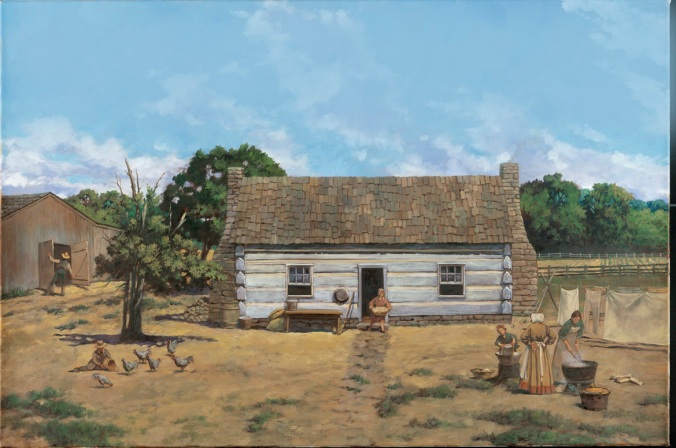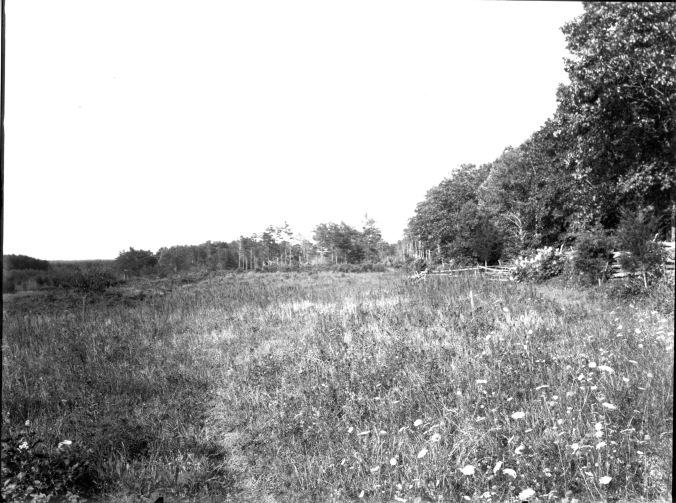From John Hennessy:
In 1895, journalist J.H. Beadle paid a visit to the battlefield at Spotsylvania Court House. He spent part of his time with Edward L. Landram, who was 13 at the time of the battle and still lived on the field. Beadle recorded his conversation with Landram carefully, and so has left us by far the best record of that family’s experience during and after the battle.

No good period image of the house survives. Using the best information available--interviews, archeology, and distant view, the park staff worked with artist Keith Rocco to created this view.
The Landram home stood about 800 northeast of the Bloody Angle. Indeed, the 170-acre Landram farm comprised much of the area covered by the Union advance on May 12, 1864, and the house was Hancock’s headquarters for some hours that day. The house suffered severely–it was virtually uninhabitable afterwards.
At the outset of the war, Edward lived there with his parents, Willis (67) and Lucy (49), and his siblings Bettie, Cornelius, and Lucy. Theirs was a common farm operation, producing a bit for market, but more for their own sustenance–a place like thousands of others, redefined by the events of a single day.
I found Beadle’s account in the [Knoxville] Daily Journal and Tribune, July 21, 1895 (it was published elsewhere as well at about the same time). It includes a number of interesting details, including the collapse of the local tourism industry in the 1890s, coinciding with a (you guessed it) recession.

Union General Hancock made his headquarters at the Landram house during the fighting at the Bloody Angle on May 12, 1864. This wartime sketch was drawn just west of the house, looking across Willis Landram's farm fields toward the Bloody Angle.
Beadle recorded that the family sensed battle was imminent and “ran down to the Court House.” “I was only 12 years old then,” remembered Edward:
Our house was first taken for a Confederate hospital, and when the Confederates fell back and the Federals came on the whole place was swept clean. All the horses were run off or killed, and a big heard of cattle were killed and everything else in the live stock line. Our house was shot all to pieces, and the furniture destroyed and the fragments taken to build breastworks, but the strangest thing was about the feather beds. When my sister and I came back, we walked along the breastworks, and she saw a piece of the ticking sticking out, so we went to work and dug and pulled and got every one of our seven feather beds out of the breastworks. What the Yankees put them in for I can’t imagine, but right along there, although it wasn’t the hardest fighting, you could walk 100 yards or so on dead bodies. This pine thicket was then an open field, but it has grown up thick since. All this field was a graveyard. The first years I worked the farm I plowed up six skeletons. Visitors from the north took them away as relics. It is a little curious that where visitors used to come at the rate of 1,000 a year or more they stopped all at once a few years ago, and now there is hardly ever one. I thought some of making a sort of tavern and trying to entertain visitors, but it won’t do now. The man who had the place the first year after father’s death plowed down all the breastworks in the fields, and some that was timber then has been cleared and the lines plowed down, and I am now very sorry that was done. Now you can’t follow the lines unless you have one who knows them well…..”
Varina Brown (A Colonel at Gettysburg, 1931, p. 256-257) also recorded a visit to the field with Edward Landram and his boyhood neighbor George Perry, who was perhaps the most famous of the Spotsylvania guides. “Mr. Landrum has cultivated his land on the crest, between the angle in the breastworks, and the west end of the hollow, every year since the battle. Mr. Perry for many years cut down trees in the Salient for his saw mill. Through their boyhood and youth they continually passed and repassed the trenches where they had seen the dead. They could not forget….”
The Landram house site today:


very Interesting account, particularly the fate of the works. I seem to remember something similar about mattresses in the Fred Cross comments.
Excellent material, John. Thanks.
It’s interesting that he describes visitors no longer coming at a certain period. I wonder when that was.
Excellent post, John.
A few years back I was walking along the trail that led from the Bloody Angle to the McCoull House site when I noticed an older man with a cane walking behind me. I stopped near the spring, as did he, and decided to make small talk. I said hello and I asked him if this was his first time visiting the battlefield. He politely told me that he had been here many times before – and that he actually grew up on the battlefield. Taken aback by his response, I asked him what he meant. He introduced himself as Bill Landrum and told me he grew up in a house that stood near the parking lot at the Bloody Angle, but still lives in the area now.
I can only imagine the memories that were passing through his head of growing up on the battlefield and the many hours spent exploring the woods and fields of Spotsylvania as a youth — places replete with weather-worn trenches and possibly debris from the great battle.
Todd Berkoff
Arlington, Va
Todd, great story..I would assume he is the grandson of Edward Landrum…?
When did the park acquire this property?
I am saddened that so little remains (country-wide) of these terrible struggles..but reading stories like the one above is always a ‘treat’.
Great article and great timing…I just finished reading about the fighting at Spotsy in Blue & Grey Magazine.
Keep up the great work.
The oak tree that was shot down, was supposedly at the end of one of the Confederate traverses along the front of the Stonewall Brigade. It was on the right of the pen which held the right hand gun of Carrington’s Charlottesville Artillery that morning. According to the battery’s Sergeant Major, Brig. Gen. James Walker of the Stonewall Brigade stood on top of the traverse to direct their firing.
While there were at least two substantial oaks shot down, it appears that this one he referred to is the one in the Smithsonian.
My great-grandfather, William Johnson, served in the Wisconsin 7th Infantry (Iron Brigade), and was killed at age 37 on May 10 1864 at the Battle of Laurel Hill, Virginia (a part of the Battle of the Wilderness). I had hoped to locate a burial place for him, but after reading this material, I realize that his was very likely in one of the many unmarked graves, or in a mass grave.
I have been unable to find any record of his service at any of the Civil War or Genealogy websites, but I do have his complete pension file from the National Archives. In addition to the notice of his death, it contains the many letters and affidavits required from his widow to prove that she and the five of their eight children under age sixteen were entitled to pension compensation.
Would anyone know the name of Generals Grant and Mott’s adjutant’s on May 15, 1864?
I have a relative adjutant Lt. Joseph C. Baldwin who returned from a 1 or 2 day visit from their camp. Baldwin was in the NJ 11th regiment. I saw a drawing marking the NJ11th with I think Grant’s group to their left.
I am curious to see if any Grant or Mott adjutant refers to the May 13, 14 or 15th 1864 meeting. Maybe Baldwin was submitting the NJ11th stats?? I would like to see if Baldwin, my relative, is mentioned and what was discussed. Glen Pierce
5/27/2012 Would anyone know if the NJ 11th or NJ 7th regiments were close by the Landram House on May 15, 1864 give or take a few days? glen pierce gpierce9@comcast.net